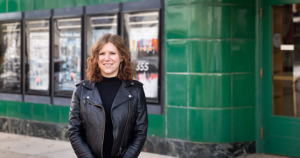The COVID-19 pandemic has made it a dangerous time to go the movies – but then, there has always been danger at the movies, said Jocelyn Szczepaniak- Gillece. From gang bombings to mass shooters to pandemics, violence has often spilled off the silver screen and into the aisles.
And still, audiences flock to see the newest release.
Szczepaniak-Gillece is an associate professor of English and the Director of the Film Studies program at UWM. She’s also a movie theater enthusiast and enjoys talking about the theater industry’s – at times – sordid history.
She did just that in her recent essay, “Bombed Pasts, Burning Futures: Notes on Demolition and Exhibition,” published in Framework. She explored how movie theaters have long been a hotbed of danger, and why we keep coming back.
A history of violence
When Prohibition’s decline inevitably led to the repeal of the 18th Amendment in 1933, the nation’s mobsters saw their bootlegging and rum-running revenue streams dry up. They looked around for another source of cash, and found it in movie theater unions.
In particular, said Szczepaniak-Gillece, Willie Bioff, an associate of the infamous Al Capone, had the idea to infiltrate the International Alliance of Theatrical Stage Employees. His idea caught on and soon mobsters were penetrating the ranks of movie theater unions throughout the Midwest and along each coast.
“There’s racketeering happening around the country at that time and this is a small element of gang activity, but they were setting off bombs (in theater lobbies and auditoriums). Stench bombs were really big, which is so disgusting,” Szczepaniak- Gillece noted. “Mobsters threatened to take away union projectionists, which is a problem because it’s really, really hard to be a projectionist at the time.”
Having a good projectionist was crucial; the film reels were heavy, the projectors were difficult to run, and nitrate film was extremely flammable – so much so that fires were a serious risk at theaters.
“There’s a reason we see ‘exit’ signs displayed really prominently in a movie theater today; it’s because of these fears of fire,” Szczepaniak- Gillece said.
As years passed and the mob lost its stranglehold on theaters, society began to worry about other hazards in its place.
“(There were) fears around, young people are going to go to movies and make out and there will be a rash of teen pregnancies,” she noted. “A major fear in the 1950s and 60s was fear of miscegenation. Most movie theaters are segregated before Civil Rights takes hold in the country. … In parts of the country, movie theaters are actually the site of Civil Rights protests.”
Later, movie theaters became targets for gun violence, the most infamous of which was the Aurora, Colorado theater shooting in 2012. Then in 2020, the pandemic brought movie-going to a grinding halt. As theaters slowly reopened, audience members had to weigh the risk of sitting in a crowded room with strangers who might be spreading COVID-19.
The overlooked victims
But if audience members have faced dangers in their brief visits to the theater, employees have worked alongside it for decades. Szczepaniak- Gillece points to a 1930s mob bombing that killed a janitor at the Lows Midland Theater in Kansas City, Missouri. These days, not only do ticket takers and snack bar cashiers work with the specter of COVID-19, but they also face the ire of movie-goers upset at masking policies.
Not to mention that job protections have declined. Szczepaniak-Gillece noted how movie theater jobs, once high-paying, salaried careers with union protection, have devolved into low-wage, seemingly low-skill positions.
“I think it’s high time to recognize that and to say that maybe there was some value to the risk when the job was stable and it paid more,” she said. “I always hope, as a historian, that my work can enable whoever is reading to think about people in the past as similar to me, as somebody I can understand. By that same token, I hope we can bring that forward to being empathetic and kind to one another.”
She hopes that theater workers will be included in the national conversation the country is facing regarding employee treatment and compensation.
‘Like democracy’
If it has been historically fraught with danger, why do people keep going to the movies?
Szczepaniak-Gillece thinks it’s for the same reasons that can make theater scary in the first place.
“You’re in a room with a bunch of people you don’t know. You’re sitting next to somebody you didn’t choose to sit next to, that you might never choose to sit next to. … And then you’re sitting there in the dark. Who knows who is sitting there in the dark?” she said.
“But those are all the factors that make it really wonderful and give it this wonderful aura of possibility. Because if everything works exactly right in a movie theater, you’re sitting with a bunch of people that you don’t know that you would never choose to be with, and you’re all thinking about the same thing at the same time. And that sounds like democracy.”
It’s dangerous. It’s messy. But the moment when the lights go down and the music starts never gets old.
By Sarah Vickery, College of Letters & Science
